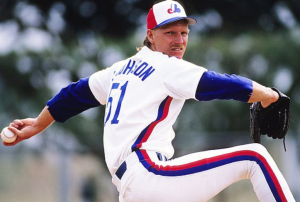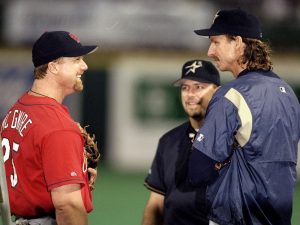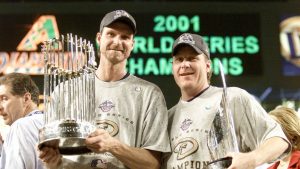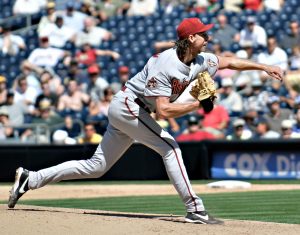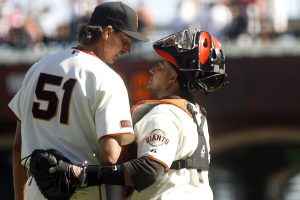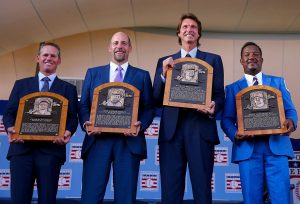Today we all know Randy Johnson, “The Big Unit,” as a hall of fame pitcher. Standing 6’10”, throwing 100 MPH, Johnson was one of the most feared and dominate pitchers to ever take the mound. We remember the 4 straight Cy Young Award seasons he had in Arizona. We remember his willingness to pitch on zero days rest in the 2001 World Series. But what many down remember is the rollercoaster start to his career.
Take a trip down memory lane and learn about the ascension of Johnson from wild flame thrower to Hall of Fame pitcher.
Montreal Expos (1988-89)
Johnson’s first few seasons were wildly entertaining and not in a good way. Hurling the ball 100 mph with no control, Johnson struggled to match his talent with success. He began his career with the Montreal Expos, making his debut on September 15, 1988 against the Pittsburgh Pirates. Johnson was good in that game, picking up the win with his 5 innings of 2 run ball.
Johnson posted a record of 3–0 with a 2.42 earned run average in four games in 1988, but 1989 was the beginning of the rollercoaster career.
In 1989, Johnson struggled in his first 7 games going 0-4 with a 6.67 ERA. This prompted the Expos to trade the left hander to Seattle on May 25th, 1989.
Seattle Mariners (1989-1998)
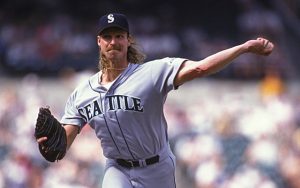
Changing leagues didn’t help Johnson control his pitches. He led the league in walks for three consecutive seasons (1990–1992), and hit batsmen in 1992 and 1993. These were the true roller coaster years for Johnson. However, in between his erratic control issues, there were flashes of greatness.
When he was able to harness his control, he was as dominant a pitcher could be. The perfect example of this is a game against the Oakland A’s in which he took a no hitter into the 9th-inning. This was just a month after a start in which Johnson allowed 4 runs on 1 hit, thanks to 10 walks in 4 innings.
Johnson’s arm talent was often compared to Nolan Ryan, another hard throwing pitcher who had his demons with control over the years. Ironically enough it was advice from Ryan that got Johnson on track and ready to excel. Ryan recommended a slight change in Johnson’s delivery and the control soon followed.
In a September 27, 1992 game against the Texas Rangers, with Ryan as the opposing starting pitcher, Johnson struck out 18 batters in eight innings. On this day I wonder if Ryan regretted just for a moment helping out Johnson. An interesting note from this game was the 160 pitches Johnson threw, a pitch count that has not been reached in an MLB game since.
1993-94: Ascend to All Star Pitcher
1993 was a break out season for Johnson. He posted a 19-8 record, with a 3.24 ERA, and 308 strikeouts. In May 1993, Johnson again lost a no-hitter to a 9th-inning single; again, the opponent was the Oakland Athletics.
One of the more memorable moments from Johnson’s career came at the ’93 All-Star Game. Johnson threw a fastball over the head of Philadelphia Phillies first baseman John Kruk, scaring the life out of him. Kruk went down swinging in a non competitive, but very entertaining at bat.
In the shortened 1994 season, Johnson was consistent with a 13-6 record with 204 strikeouts. This was just added momentum and confidence for the 1995 season.
1995 Season: AL Cy Young Winner
The 1995 season was the first truly dominant season form beginning to end. With an 18–2 record, 2.48 ERA and 294 strikeouts, Johnson took home his first Cy Young Award. His .900 winning percentage was the second highest in AL history. Johnson became the first regular starting pitcher in history to strike out more than a third of all batters faced.
The Mariners late season comeback was completed when Johnson took the ball in a one game playoff to advance to ALDS. In this start, he pitched a three-hitter, striking out 12 Angels on the way to a victory.
By the time Johnson took the mound against the Yankees in the ALDS, the Mariners were facing elimination down 2-0. But in Game 3, Johnson struck out 10 in seven innings. The Mariners would win both games 3 and 4, forcing a must win game 5.
On only one day’s rest, Johnson made a dramatic relief appearance in Game 5. Entering a tied game in the ninth inning, Johnson pitched the ninth, 10th, and 11th innings. He allowed one run, struck out six, and held on for the series-ending win in Seattle’s dramatic comeback.
1996-98: Final years in Seattle
Johnson missed most of the 1996 season with a back injury, but bounced back strong in the 1997 season. In 1997 he posted a 20–4 record, with 291 strikeouts, and a 2.28 ERA. A noteworthy statistic from the season is that Johnson had two 19-strikeout starts.
Johnson once again had a memorable All-Star Game moment in 1997. This involved his former teammate Larry Walker, who sat out a game during the season when Johnson and the Mariners faced his Montreal Expos. His reason being Johnson almost killed him in a spring training game years ago with a fastball.
In this exchange during the all star game, Johnson fired a fastball over the head of Walker, getting laughter from everyone in the stadium. Walker placed his batting helmet backwards and switched sides in the batters’ box to stand right-handed for one pitch.
When the 1998 season started, Johnson was at odds with the Seattle front office. He wanted an extension and the Mariners would not offer him one, despite his current deal expiring at years end. After a 8-20 record in June, the Mariners fell out of contention and decided to trade their best pitcher to the Houston Astros.
1998: Dominance in Houston
In 11 regular-season starts with the Astros, Johnson posted a 10–1 record, a 1.28 ERA, and 116 strikeouts in 84⅓ innings and pitched four shutouts. This impressive second half earned Johnson votes for the NL Cy Young despite only being in the league half the season. He wouldn’t win the award, but it is a hell of an accomplishment to even receive votes.
The dominance would translate to the postseason as well, but the team support wasn’t there for Johnson to win any games. Giving up a combined 3 runs in his two NLDS stars, Johnson lost because of lack of run support. The Astors would be eliminated, and Johnson was set to hit the free agent market.
1999-2004: 4 Straight NL Cy Young Awards In Arizona
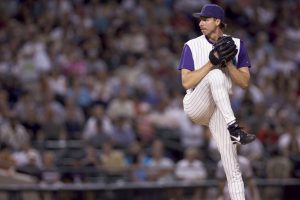
Johnson agreed to a four-year contract, with an option for a fifth year, for $52.4 million, with the Arizona Diamondbacks. This was quite the splash for a franchise in just their second year in existence. Johnson literally put the Diamondbacks on the map when he signed.
1999 Season: 1st NL Cy Young
Johnson led the team to the playoffs that year by putting them on his back. With a 17–9 record and 2.48 ERA with 364 strikeouts, leading the majors in innings, complete games and strikeouts, Johnson won the NL Cy Young award. Johnson joined Gaylord Perry and Pedro Martínez as the only pitchers to have won the Cy Young Award in both the American and National Leagues.(Roger Clemens, Roy Halladay and Max Scherzer have since joined the list.)
2000 Season: 2nd NL Cy Young
Johnson finished 2000 with 19 wins, 347 strikeouts and a 2.64 ERA, and won his second consecutive NL Cy Young Award. The Diamondbacks would also add Curt Schilling to the team in July. This is the first time Johnson had another ace alongside him. The duo would form a deadly 1-2 punch.
2001 Season: 3rd NL Cy Young and World Series Champion
The 2001 season was iconic for the Diamondbacks franchise and Johnson himself. Winning his 3rd consecutive NL Cy young award, Johnson was at the pinnacle of the sport. He went 21-6 with an absurd 372 strikeouts.
Among the highlighted games form his season are his 20 strikeout game on May 8th against the Reds. On August 23rd, 2001, Johnson became the 30th pitcher in history to have an immaculate inning, striking out three batters on 9 pitchers.
If you were wondering who finished second in the Cy Young voting, it was his teammate Curt Schilling. These two would out the team on their backs all season and postseason long.
In the fourth year of the Diamondbacks existence, Johnson and Schilling carried the team to their first World Series appearance and victory in 2001 against the New York Yankees. Johnson and Schilling shared World Series MVP honors for their dominant outings neutralizing a lethal New York offense.
Johnson’s performance was particularly dominating, striking out 11 in a 3-hit shutout in game 2. He pitching seven innings for the victory in Game 6 and then came on in relief the following day to pick up the win in Game 7. It was almost two decades ago and it still ranks as one of the most impressive feats in the sport.
2002: 4th NL Cy Young
In 2002, Johnson won the pitching Triple Crown, leading the NL in wins, ERA and strikeouts. Obviously this earned him his 4th consecutive NL Cy Young Award, with teammate Schilling once again finishing second. It was Johnson’s fourth consecutive 300-strikeout season with the Diamondbacks, and fifth consecutive overall, extending his own MLB record.
Despite the Big Unit’s 4th Cy Young, the Diamondbacks would not repeat as World Champions.
2003-04: Down years in Arizona
While missing most of the 2003 season due to injury, Johnson bounced back in 2004 season.
On May 17th 2004, at age 40, Johnson pitched the 17th Perfect game in MLB history. He became the oldest pitcher to accomplish this feat.
On June 29, 2004 Johnson become only the fourth MLB player to reach 4,000 strikeouts in a career.
He finished the 2004 season with a 16–14 record, and the 14 losses were not because he pitched poor. The offense really gave him run support, and when they did he won. In games he received three or more runs, Johnson was 13–2. Because the team was so bad, Johnsons’ 16 wins accounted for 31.3% of his teams wins.
2005-06: New York Yankees Tenure
The Diamondbacks traded Johnson to the New York Yankees for Javier Vázquez, Brad Halsey, Dioner Navarro, and cash in January 2005. In his first year in Yankees pinstripes, Johnson finished with a 17–8 record with a 3.79 ERA. He also finished second in the AL with 211 strikeouts.
Johnson got rocked in his ALDS Game 3 starts giving up 5 runs on 2 homers in just 3 innings pitched. He would come in and have an effective Game 5 relief appearance but the Yankees would get sent home by the Angels.
2006 was a rough go for the 42 year old. Johnson finished the season with a 17–11 record, but with a terrible 5.00 ERA and just 172 strikeouts. It was later found out that he pitched the entire season with a herniated disc in his back. The Yankees once again were eliminated in the ALDS and Johnson’s time in the Bronx was up.
2007-08: Back in the Desert
In January 2007, the Yankees traded Johnson back to the Diamondbacks, almost two years to the day that Arizona had traded him to New York. The Yankees’ decision to trade Johnson was primarily based on a off-season conversation he had with Yankees General Manager Brian Cashman. Johnson expressed the importance of being closer to his family in Phoenix after the death of his brother, and the Yankees granted his wishes.
The 2007 season was one filled with injuries and rehab for the 43 year old. He never fully recovered from the back injury he had with New York. Johnson had season-ending surgery on the same disc, this time removing it completely.
Jonshon would return on April 14, 2008 against the San Francisco Giants, eight months following his back surgery. On June 3, 2008, Johnson struck out Mike Cameron of the Milwaukee Brewers for career strikeout number 4,673. This strikeout meant Johnson passed Roger Clemens for 2nd on the all time strikeout list. He finished the season with an 11–10 record and an ERA of 3.91
2009: San Franciso Giants
At age 45, Johnson signed a one year deal with the San Francisco Giants.
Johnson became the 24th pitcher to reach 300 wins, beating the Washington Nationals (the team that he first played for when they were known as the Montreal Expos) on June 4 at Nationals Park in Washington, D.C.
Returning from a torn rotator cuff, Johnson finished the season out of the bullpen. On September 19, 2009, Johnson made his first relief appearance in 4 years, facing the Los Angeles Dodgers for 3 batters.
Retirement and the Hall of Fame
On January 5, 2010, he announced his retirement from professional baseball. Johnson was inducted into the Mariners Hall of Fame on January 17, 2012.
Johnson was selected to the Baseball Hall of Fame in his first year of eligibility in 2015. The Diamondbacks retired his number on August 8, 2015.
In Case You Missed it:
What if Melo was drafted by the Pistons?
